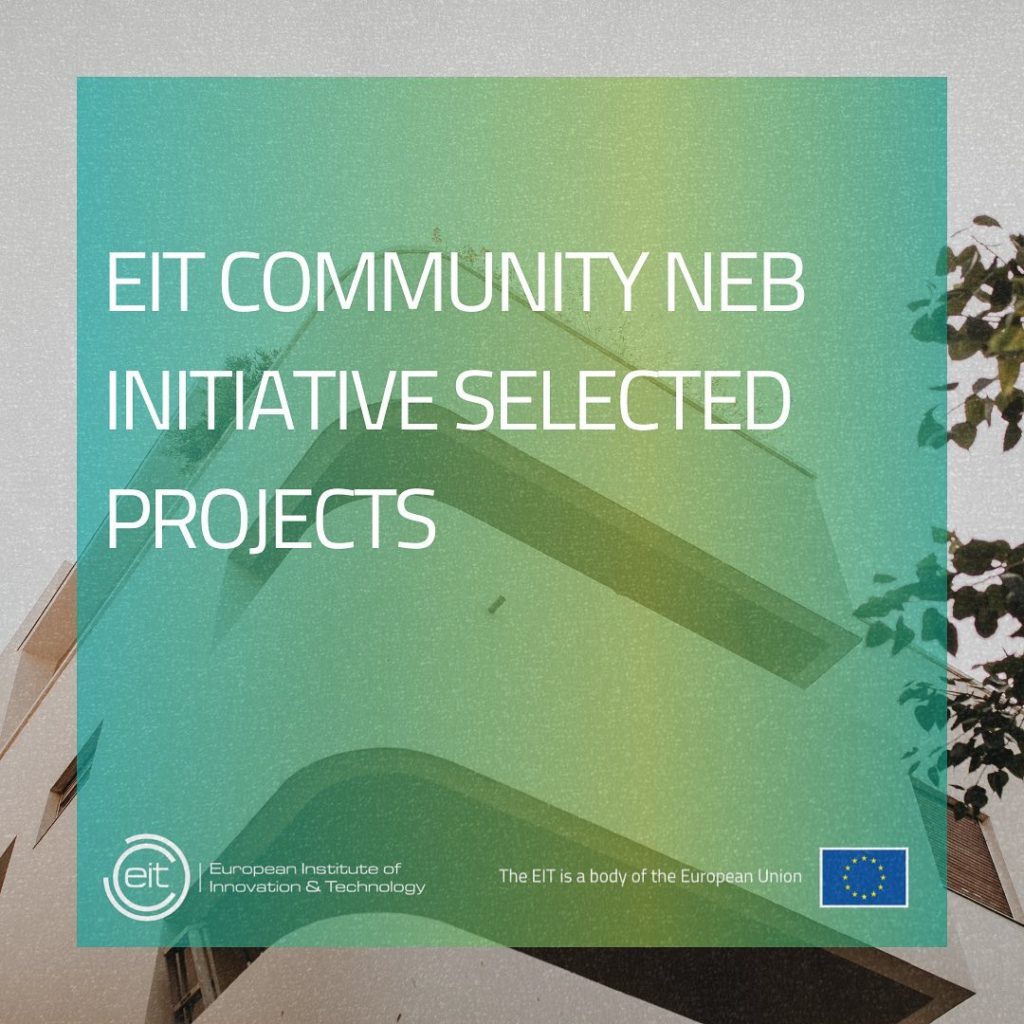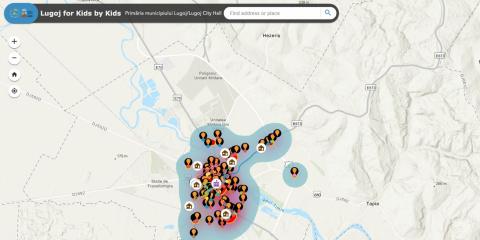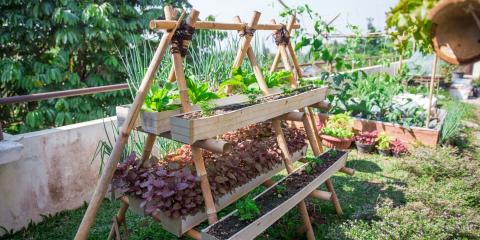EIT Community New European Bauhaus initiative selected citizen engagement projects
The New European Bauhaus initiative (NEB) is an environmental, social and cultural initiative to combine the aesthetic experience, sustainability, and inclusivity complimenting the European Green Deal.

Mapping challenges and developing solutions in collaboration with citizens is key to delivering transformation. Citizen engagement that reflects the diversity of voices in the community is essential to developing long-term solutions that match the wider community’s needs—working together for an expected higher goal results in a true synergy of innovation, creativity, and design, improving citizens’ quality of life in cities. For citizens, this can increase social acceptance of change and encourage a shift to more sustainable behaviours. Moreover, it can help the private sector adapt and tackle regulatory frameworks and reconsider the fundamental value systems and norms they are founded upon. Successful citizen engagement will increase the ability to create, experiment, demonstrate, scale, and deploy innovative solutions for a just, equitable and prosperous future. ω

The European Institute of Innovation and Technology (EIT), together with its thematic pan-European Innovation Communities, is well placed to play a vital role in the design, delivery and dissemination phases of the NEB. A close collaboration between the EIT Community (namely EIT Food, EIT Urban Mobility, EIT Climate KIC and EIT Digital) in 2021 focused on new citizen engagement activities and capitalising on existing innovative solutions and scaling them to cities.
Through their activities, they have tested the application of Bauhaus principles to current challenges facing the world, such as climate, mobility, digital, health and food challenges. They have further positioned these activities in the context of the global pandemic and economic and social recovery. Finally, we examine which of the Bauhaus principles can be replaced with new ways of thinking and actively question the humanist ideas behind the movement using the Knowledge Triangle, bringing together business, academia and citizens to develop and test new concepts of future ways of living. Discover the selected projects that were conducted under two EIT – New European Bauhaus calls,
- Citizen engagement
- Capitalising on existing innovative solutions and scaling them to new cities
Selected projects from the NEB Citizen Engagement Call
The aim of this Cross-KIC NEB Calls for proposals was to work on activities where citizens and end-users are asked to identify relevant challenges of their city and empowered to co-create together potential solutions in an ideation process.
EC Boost Mataro Lab (Mataró, Spain)

The project boosted local energy communities among vulnerable consumers of the neighbourhood of Cerdanyola, a deprived area in Mataró. Supporting an open business model for self-consumption installations in energy communities for social economy entities (commercials, technicians, mediators, ethical banks, etc.), catapulting the contribution of entities with social and environmental value in cooperation with the municipality and the citizens. ECOSERVEIS has developed a business model for self-consumption energy communities based on SSC (the MONDCE project, currently ongoing), which served as the basis for the reflective process regarding access to energy in Mataró and definition and boosting of future energy communities.
The EC-Boost Mataró Lab project brought energy players and citizens together, with the aspects of new initiatives arising, combined with massive sensitisation and engagement campaigns. Through the project’s development, the local authority’s implication has been vital to getting to know the local context. The municipality had no experience either in shared self-consumption or communitarian projects. Therefore, this project shared several business models to implement a public-communitarian collaboration. The project listed different case studies and grouped them into three different categories. The three core business models identified and suggested for the municipality to build innovative public-communitarian energy production initiatives along with citizens, including vulnerable users, are as follows:
- Rooftop leasing to third parties
- Leasing of the use of PV panels with fee or fee-free
- Public-communitarian collaboration
Adopt the Ugly Foodling (Oulu, Finland)

The main objective of the Ugly Foodling project was to create awareness among young consumers about the reasons and challenges of food waste and bring them together with more experienced consumers (elderly) who spend their youth in different conditions (non-abundance of food, participation in food-producing etc.).
The Ugly Foodling represents food that is still edible or still has value, but it ends up in the rubbish. The work of the co-creation event focused on changing the fate of the Ugly Foodlings towards a sustainable and inclusive “happier end” for all, the environment, the city and its citizens, the food producers. Four storylines of the adventures of the Ugly Foodlings at the food production site, in the market, in the restaurant and at home will be produced by the young adult participants and presented in digital format.
Lugoj for kids, by kids (Lugoj, Romania)

The project “Lugoj: For kids, by kids” improved the public space in the town of Lugoj, Romania, through an innovative “grassroots” approach by connecting pupils with the public administration. The main objectives of the “Lugoj – For kids, by kids” project were to identify, with the help of pupils, obstacles children face in cycling to school, using the relevant infrastructure, and co-create solutions. The secondary aim of the pupil engagement phase was to stimulate their participation and involvement in the decision-making processes of their school by forming a long-term working group to deal with school projects. The pupils and the municipality formed a powerful bond and connected through a shared vision, improving the public realm through Creation of a GIS StoryMap showcasing problematic areas of the cycling infrastructure in the town and proposed solutions.
The project’s main output is the visualised ArcGIS based Interactive and Story Maps, which offers the possibility to visualise in real-time the information and data collected (entered) by the students involved in the project.
Selected projects from the NEB Capitalisation Call
This Cross-KIC NEB call will offer regions, cities or affiliated entities the possibility to select project solutions to drive a specific challenge in their urban transformation. Cities and regions can benefit from existing work aiming for immediate impact within 2021. The following projects contributed to higher use rates, improved physical facilities, urban greening, more inclusive access, and active mobility.
“Orti Urbani” Container gardening project (Turin, Italy)

The container gardening project contributed to the aesthetic and functional redevelopment of a part of the University of Turin that has been unused and abandoned for years, including a waste dump. The idea is to use the paradigm of the New European Bauhaus applied to urban regeneration and the redevelopment of a place through food. The material used for building the infrastructure is completely retrieved through circular economy processes. In particular, a co-design and co-creation of a space dedicated to producing fruit and vegetables through container gardens were used.
The creation of the box gardens was done by implementing a co-creation process and co-design of the area in question. The mapping of local actors was carried out, and collaborative and co-designing relationships were activated. Specifically, in addition to several visits by students, lecturers and administrative staff representing university citizenry, the project also involved citizens, elders, and a nursery school, and created a network with other urban garden initiatives in the city, as well as interacting with a social cooperative that manages urban gardens in a neighbouring area and the citizen hub that deals with the social inclusion of disabled people grouping all the leading relevant organisations. During the meetings, the spaces, management rules, stakeholder needs, inclusive design, crops, and types of plants were co-designed and co-selected. Later, the area was also cleared of 860 kg of waste. The history of the site was reconstructed, also from the point of view of the tree species that were present. The choice of plants was inspired by the stories we heard and the various testimonies of those who grew up in these spaces.
CLIME – transgenerational climate voyage through time and space via AR technology (Pula, Croatia)

The CLIME project was designed to optimise heritage experiences to climate resilience and the recent experience of climate and connected cultural change and adaptation and inclusivity and revive ‘Councils of Elders’ connection with youth. The purpose is inverting the relationships between city and nature by conceptualising cities in the natural environment by providing a gamified AR mobile app, the Equinox XR, for youth, where they can “clime” both physically through nature and culturally as experienced by our elders.
In Western culture, independent living “devalues” people as they age. The generation gap is highly pronounced, with the elderly being socially excluded and their knowledge and experience not visible. Therefore the main goal was to connect generations in a common goal of tackling climate change by using technology to share an experience that stretches over the lifetime of elderly citizens and benefiting from their strategies of living in rapid climate change. By mapping the narratives of the elderly, an AR tour of the city and city surroundings was designed, through which educational content on sufficiency will be adopted in a fun and recreational way.
The “Clime” AR mobile app connect generations and give us educational content about life in the past, life before plastic, before significant climate change, about the self-sufficient life of our elders. With this mobile application, users will be able to take a tour of Pula, generate a physical map of the city of Pula based on stories and create an open database based on research.
Furnish (Barcelona, Spain)

From 2020 the Municipality of Barcelona has set the project “Protegim les escoles” as a high priority strategy to provide Barcelona’s schools with safe, comfortable, and healthy public spaces that act as meeting places for children, their families and neighbours. By 2030, it is expected that all the 585 schools in Barcelona will offer safe and comfortable surroundings. In line with this, FURNISH emerges as an opportunity to help in this pacification. The project provided interesting and instigating interactive prototypes to stimulate permanence in these areas. These places have the potential to work as transitional spaces, connecting the urban and school environments creatively, promoting more extended stays before and after school hours, and enabling its use as extensions of classrooms and playgrounds, engaging children to play, be active and learn.
The school community had tested the prototypes, and their implementation integrates the engagement of the school community in the decision-making process. Two teams were selected to develop the co-creation process and composed by Fab Labs, research groups, architects, engineers, designers and makers; they were able to produce rapid solutions to the urgent spatial opportunities of the new public space. The activities were mainly focused on the co-design and co-fabrication processes, the citizen engagement activities (including co-creation workshops, presentations and participatory construction of elements) and the assessment and impact analysis. An essential part of the design strategy for the prototype were the ideas of participation, modularity, and sustainability.
Support your favourite project
All of the granted projects had been published on the Decidum platform EIT Community New European Bauhaus website to give more visibility and outreach to them. Through the Decision platform, interested parties can participate in the process by supporting projects and giving their feedback and filling in the survey until 31st March 2022.
Original Post: https://eit.europa.eu/news-events/news/eit-community-new-european-bauhaus-initiative-selected-citizen-engagement-projects
